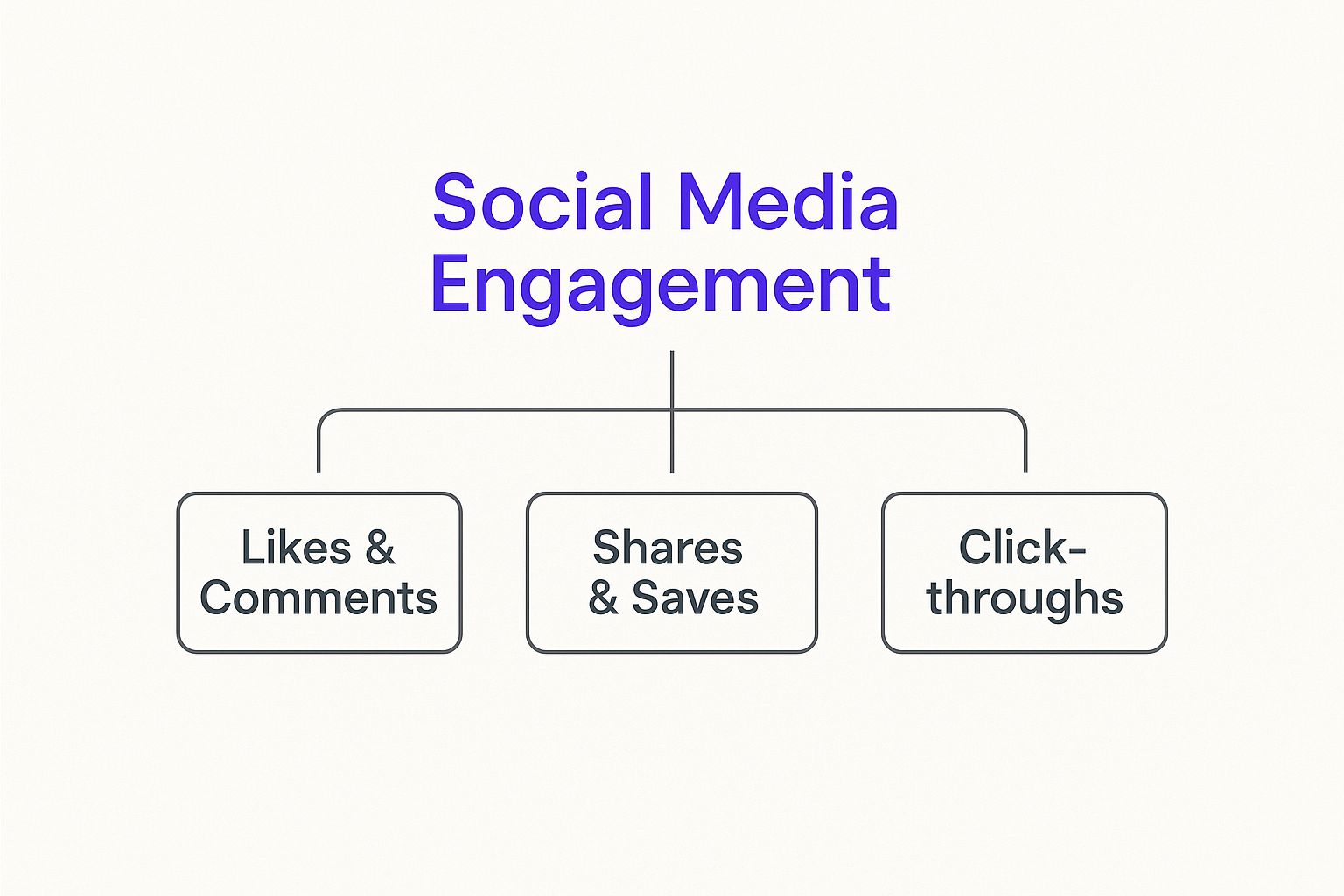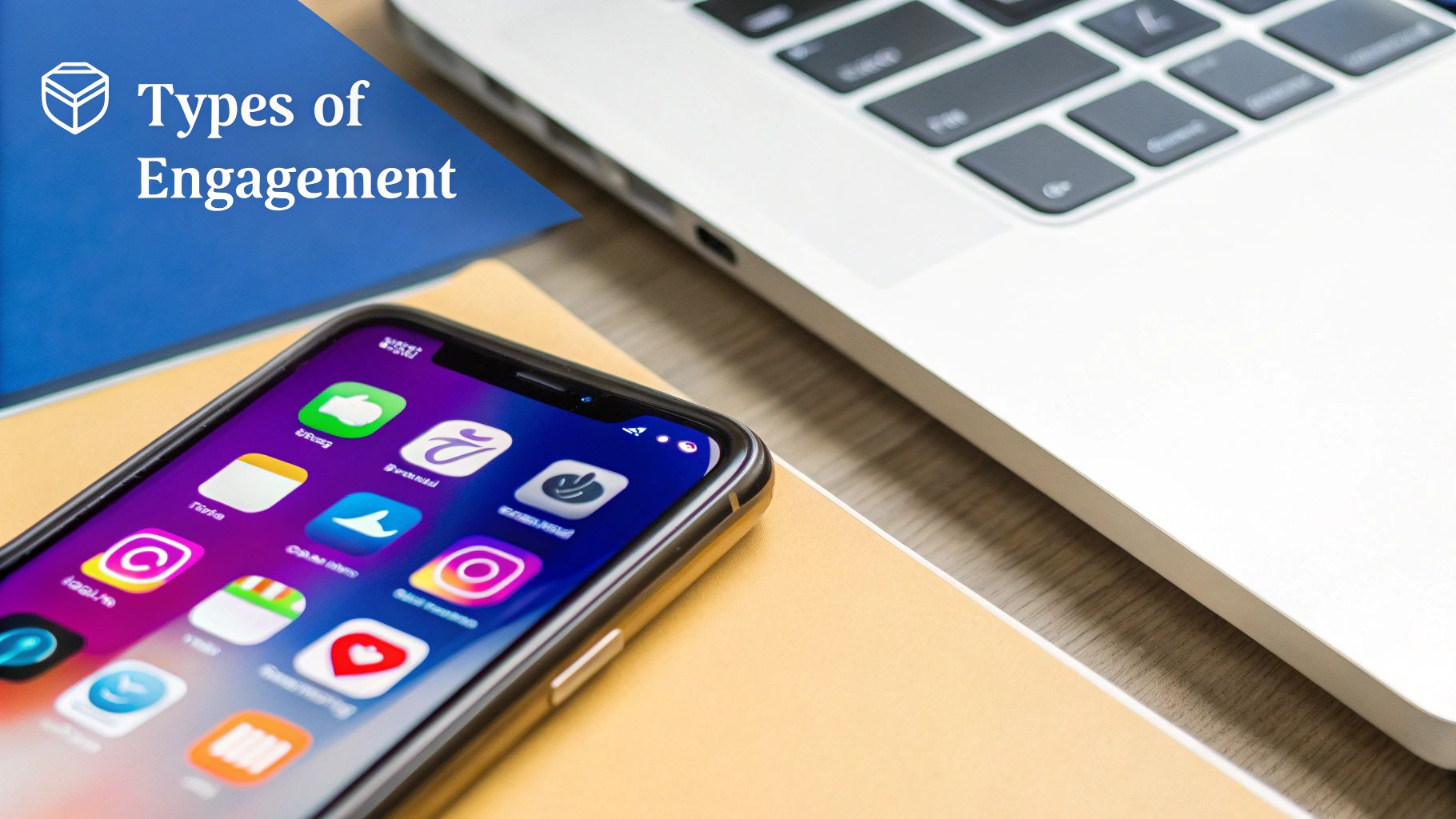What Is Social Media Engagement and How to Boost It
Discover what is social media engagement and why it's vital for growth. Learn to measure and implement proven strategies to build a loyal online community.
Posted by
Ever feel like you're just shouting into the void on social media? You get a few likes, maybe a new follower, but it doesn't feel like anyone is actually listening. That's where social media engagement comes in.
It’s the pulse of every meaningful interaction between your brand and your audience. Engagement goes way beyond vanity metrics—it's the real measure of the quality of the digital relationship you're building with the people who follow you. Every single one of these actions is a powerful signal of interest and loyalty.
Understanding Social Media Engagement Beyond Likes
Let's think of your social media feed like a bustling coffee shop. A 'like' is just someone nodding as they walk past your table. It's a nice, simple acknowledgment, but that's about it.
But a comment? A share? A save? That’s someone pulling up a chair to join the conversation. That distinction is the heart of what social media engagement is all about. It’s not just about being seen; it's about genuine connection.
Every action a user takes is a form of communication. Passive stuff, like views, tells you people are aware of you. But the active interactions—the comments, DMs, and shares—show a much deeper level of interest and endorsement. This is how you turn a one-way broadcast into a two-way dialogue, transforming followers into a real community and, eventually, into powerful brand advocates.
These engagements also act as a powerful form of social proof, showing potential new customers that your brand is trusted, valued, and worth paying attention to.
The Four Tiers of Social Media Engagement
Not all engagement is created equal. Some actions take a split second, while others require genuine thought and effort from your audience. Understanding this spectrum helps you see what's really resonating.
We can break these interactions down into four key tiers, from the lowest effort to the highest.
| Engagement Tier | User Actions | What It Signals to a Brand |
|---|---|---|
| Tier 1: Passive Observation | Views, Impressions, Reach | "I see you." This is the baseline of awareness. Your content appeared on their screen, but it didn't necessarily stop the scroll. |
| Tier 2: Low-Effort Interaction | Likes, Reactions (e.g., ❤️, 😂) | "I like this." A quick tap shows approval or emotional resonance. It's a positive signal but requires very little commitment. |
| Tier 3: Active Interest | Comments, Saves, Clicks, Poll Votes | "I'm paying attention." This user is invested enough to type a response, save your content for later, or click to learn more. They're leaning in. |
| Tier 4: High-Intent Advocacy | Shares, Mentions, DMs, User-Generated Content (UGC) | "You need to see this." This is the holy grail. The user is actively endorsing your brand to their own network. It's a powerful vote of confidence. |
Seeing your engagement through this lens gives you a much richer picture. A post with tons of shares and saves, even with fewer likes, is often more valuable than one with a mountain of likes but no other interaction.
This hierarchy shows exactly how different actions signal deeper levels of commitment and interest in what you have to say.

Let’s be real, though—getting this attention is incredibly competitive. You're up against a lot of noise. With an estimated 5.45 billion social media users worldwide, brands are constantly fighting to stand out.
People are logging on for all sorts of reasons, from connecting with family (48.7%) to finding product inspiration (26.6%). Every single piece of engagement you earn is a hard-won signal that you’re delivering something relevant and valuable.
Why High Engagement Is Your Most Valuable Asset
Let's get one thing straight: high social media engagement isn't about vanity metrics. Forget the fleeting rush of notifications piling up. Real engagement is the engine that powers actual business growth.
Think of it less as a popularity contest and more as the currency of customer trust. When your audience actively interacts with your content—leaving comments, sharing posts, saving ideas—it sends a powerful signal that goes way beyond simple brand awareness.
Every single one of those interactions tells the social media algorithms that what you're posting is valuable. That it's worth showing to more people. This kicks off a snowball effect. An initial flurry of engagement on a post signals to platforms like Instagram or Facebook that they should push it to a wider audience. This bigger audience then engages, creating a cycle of visibility you could never achieve by just shouting into the void.
This is organic amplification at its best. You're not just broadcasting a message; you're starting a conversation that the platform itself wants to promote because it keeps users on their app.

Building a Strong and Loyal Community
An engaged audience doesn't just stick around; it evolves into a loyal community. These people aren't just followers. They become brand advocates who will defend, promote, and champion your business without you even asking.
When you consistently make an effort to have a two-way dialogue, you're building real relationships that go far beyond the screen. This connection pays off in a big way. Consider this: 86% of consumers say authenticity is a huge factor when deciding which brands to buy from. An engaged community feels that authenticity because you've made them part of your brand's story.
Gathering Priceless Customer Feedback
Your comments section is pure gold. It's one of the most valuable, unfiltered sources of customer feedback you could ever ask for. Every interaction is a chance to learn what your customers love, what they're confused about, and what they wish you would do next.
- Product Development: Are people constantly asking for a specific feature or a new color? That’s direct input for your next product launch, straight from the source.
- Content Strategy: Do your behind-the-scenes posts get all the comments? That's your audience telling you exactly what kind of content they want to see more of.
- Customer Service: When you answer a question publicly, you're not just helping one person. You're showing everyone else that you're responsive, you're listening, and you actually care.
Driving Real Business Results
At the end of the day, this all leads to one thing: turning followers into customers. When people trust your brand and feel connected to what you're doing, they are so much more likely to make a purchase.
Engagement builds the foundation of trust needed to turn casual interest into actual sales. It’s the bridge between just having an online presence and having an online business that actually thrives.
Breaking Down the Key Social Media Engagement Metrics
To really get what social media engagement is all about, you have to learn to speak its language. And that language is data, with each metric telling a different part of your audience's story. It goes way deeper than just counting followers.

Think of these metrics as different levels of a conversation. Some are just a quick nod, while others are full-blown, meaningful discussions. Figuring out the intent behind each one is how you start measuring what actually matters.
The Building Blocks: Core Interactions
These are the most basic actions people take on your content. They might seem simple, but each one signals a different level of investment from your audience.
- Likes and Reactions: This is the easiest, most common form of engagement. It’s a passive thumbs-up, a quick nod that says, "I see this, and I approve," but it requires almost no effort.
- Comments: Now we're talking. A comment is a big step up from a like because it’s active participation. Someone actually stopped, thought about what you said, and typed out a response. This opens the door for a real conversation.
- Shares: A share is the ultimate compliment. When someone shares your content, they’re putting their own reputation on the line and vouching for you to their entire network. They're basically acting as a brand advocate.
- Saves: This metric is pure gold. A save means someone found your content so useful or inspiring that they want to come back to it later. It's a massive signal that you’re creating high-value stuff.
These interactions are the foundation, but they don't tell the whole story. To see the bigger picture, you have to look at how your content is performing overall.
The Big Picture: Key Performance Indicators
Performance metrics give you a bird's-eye view of your social media strategy's health. They show you how people are finding your content and how well it's grabbing their attention.
To get a true handle on your performance, you need to be dialed into the top social media metrics to track for success that actually move the needle.
- Impressions: This is simply the number of times your post was shown on a screen. It measures potential exposure, not whether anyone actually stopped to look.
- Reach: This is where it gets more interesting. Reach counts the number of unique people who saw your post. It answers the question, "How many individual eyeballs did I get in front of?"
- Click-Through Rate (CTR): This is a huge one. CTR measures the percentage of people who saw your post and actually clicked a link in it. It's vital for knowing if your content is successfully driving people to take action, like visiting your website.
The real MVP of performance metrics? Your Engagement Rate. This simple formula pulls all your core interactions together and measures them against your audience size, giving you a clear benchmark for success.
The most common way to calculate it is: (Total Engagements ÷ Total Followers) x 100.
This single percentage is your North Star. It helps you track how you're doing over time and lets you see which types of content truly connect with your audience. And in today's world, that's more critical than ever. The average user is active on nearly 6.84 different social platforms every month, and 58% of consumers say they discover new businesses right on social media.
How to Measure and Analyze Your Engagement
Alright, so you get what engagement is. But knowing how to actually measure and analyze it? That's where the real magic happens. Data is just a bunch of numbers until you learn how to read it—turning raw stats into smart decisions that actually grow your brand. This is how you go from just "posting stuff" to building a real, data-driven strategy.
The good news is you don’t need a bunch of fancy, expensive tools to get started. Most social media platforms have some seriously powerful analytics built right in, and they're completely free.
- Instagram Insights: This is your go-to for seeing what’s hitting home. It gives you detailed data on your posts, stories, and audience demographics, showing you exactly what content is earning the most saves and comments.
- Facebook Business Suite: Think of this as your command center for Facebook and Instagram. It offers deep dives into your reach, engagement trends over time, and who your audience really is.
- Native Platform Analytics: Don't sleep on the tools inside TikTok, LinkedIn, and X (formerly Twitter). They give you a direct window into your performance, helping you understand the unique quirks and trends of each platform.
These built-in tools are your first stop. They’re perfect for getting a baseline understanding of what engagement looks like for your specific audience.
Moving Beyond Native Tools
While the native tools are fantastic for day-to-day check-ins, dedicated third-party dashboards can save you a ton of time and streamline your analysis. Tools like Buffer or Hootsuite pull all your data from every profile into one clean dashboard. This makes it so much easier to spot cross-platform trends and pull together reports that actually make sense.
If you're looking to level up, you can explore a whole world of powerful social media analytics tools that fit different needs and budgets. These platforms often come with more advanced features, like competitor tracking and automated reporting, giving you a much clearer picture of where you stand.
The goal isn't just to collect data—it's to turn that data into a story. Your analytics should answer the big questions: Which content formats spark the best conversations? What topics get people to hit the share button? That’s the heart of smart analysis.
Calculating Your Engagement Rate
To really know how you're doing, you need a simple, consistent way to benchmark your performance. The most common and straightforward way to calculate your engagement rate is by looking at it relative to your follower count.
Here's the formula:
Engagement Rate = (Total Engagements on a Post / Total Followers) x 100
This little formula gives you a clean percentage you can use to compare different posts and track your progress over time. So, if a post gets 200 engagements and you have 5,000 followers, your engagement rate for that post is a solid 4%.
This matters more than ever in our mobile-first world. A staggering 80% of all social media activity happens on phones. People are scrolling for personal reasons—to stay in touch with family (48.2%) or just to fill a few spare minutes (36.8%).
Understanding these habits helps you create content that feels natural and fits right into their daily routine. When you track your engagement rate, you're really just measuring how well you're connecting with them in those small, everyday moments.
Proven Strategies to Increase Social Media Engagement
Okay, so you understand the metrics. Now for the fun part: actually making them go up.
Boosting your social media engagement isn't about chasing a one-off viral moment or deploying cheap tricks. It’s about building a space where your audience feels seen, heard, and genuinely wants to hang out. It's a long game, but it's the only one worth playing.

Think of this as your playbook for turning passive scrollers into an active, loyal community. When you focus on authentic, two-way communication, you start building real relationships that lead to real business growth. These strategies are battle-tested and designed to get genuine conversations flowing.
Spark Conversations with Questions and Polls
The absolute simplest way to get a response? Just ask for one. Stop broadcasting at your audience and start inviting them into a discussion. A thoughtful question in your caption can completely change the dynamic, making your feed feel more like a coffee shop conversation than a billboard.
For example, a home decor brand could ask, "What's the one color you'd never use in your living room? Spill the tea!" It's far more interesting than just posting another picture of a couch.
Better yet, lean into the interactive features these platforms build for you. Instagram Stories, in particular, are a goldmine for this.
- Polls: Throw up a simple A/B question to get quick takes.
- Quizzes: Test your followers' knowledge about your industry or brand trivia.
- Question Stickers: Host an AMA (Ask Me Anything) session and let your audience lead.
These little features are brilliant because they lower the barrier to entry. A quick tap on a poll is an easy first step that warms people up for more meaningful interactions later on.
The core lesson here is that authentic value, not cheap tricks, is the key to sustainable engagement. When you treat your social media as a community hub rather than a billboard, genuine interaction will follow.
Run Contests and Encourage User Generated Content
Nothing injects a shot of adrenaline into your feed quite like a contest or giveaway. These events can create a huge spike in engagement by giving people a real reason to participate right now. The trick is to build the entry requirements around interaction—things like commenting, tagging friends, or sharing the post.
To take it a step further, design contests that create User-Generated Content (UGC). Ask your audience to share photos or videos of themselves using your product with a unique hashtag. This is a powerful one-two punch: it floods your feed with genuine social proof and makes your customers feel like they're a part of your brand's story. If you want to go deeper, check out how to build a powerful user-generated content strategy that turns customers into your best marketers.
And when you re-share that UGC (always with permission and credit!), you’re not just getting free content. You’re validating your customers and inspiring everyone else to join in.
Commit to Community Management
Social media is a two-way street. Simple, right? But so many brands miss this. If you ignore comments and DMs, you’re basically telling your audience that their opinions don’t matter.
Honestly, one of the most powerful things you can do is just be present.
Commit to replying to comments quickly, even if it's just a simple emoji or "Thanks for sharing!" It shows there's a real person behind the account who's actually listening. That human touch can turn a casual follower into a die-hard fan.
Engagement Strategy vs Platform Fit
Not all strategies land the same way on every platform. A poll that crushes it on Instagram Stories might fall flat on LinkedIn. Tailoring your approach is key.
Here’s a quick guide to help you match your strategy to the right platform:
| Strategy | Best for Instagram | Best for Facebook | Best for LinkedIn | Best for TikTok |
|---|---|---|---|---|
| Questions & Polls | ✅ Excellent (especially Stories) | ✅ Good (in posts & groups) | ✅ Good (polls & text posts) | ✅ Excellent (stickers & comments) |
| Contests & Giveaways | ✅ Excellent | ✅ Excellent | ⚪️ Situational | ✅ Excellent |
| UGC Campaigns | ✅ Excellent | ✅ Good | ⚪️ Situational (B2B testimonials) | ✅ Excellent |
| Responsive Community Management | ✅ Critical | ✅ Critical | ✅ Critical | ✅ Critical |
While being responsive is non-negotiable everywhere, you can see how other tactics need to be adapted. This is why knowing your platform's culture is so important. For example, there are strategies specifically for increasing engagement on TikTok that wouldn't make sense anywhere else.
Active participation also sends a powerful signal to the algorithm: it sees that your content is sparking valuable conversations, which in turn can boost your visibility. It's a true win-win. Your audience feels appreciated, and your content gets an organic lift.
Got Questions About Social Media Engagement? We've Got Answers.
Let's be real—navigating the world of social media engagement can feel like you're trying to solve a puzzle with half the pieces missing. As you start digging into your strategy, a lot of questions pop up. Am I doing this right? Is this normal?
Let's clear the air and tackle some of the most common questions that come up. Getting these fundamentals right is the difference between spinning your wheels and actually getting somewhere.
What’s a Good Social Media Engagement Rate, Really?
This is the big one, isn't it? Everyone wants to know the magic number. But the truth is, there isn't one. You'll hear people throw around a general benchmark of 1% to 5% as "good," but that number is all over the place depending on your industry, the platform, and how big your audience is.
A small, niche brand with a super-passionate following might pull a 10% engagement rate without breaking a sweat. Meanwhile, a massive global corporation might celebrate a 1% rate because that still represents a huge number of people. So, the best move you can make is to stop comparing your numbers to some universal standard and start benchmarking against yourself.
Your real goal should be slow, steady improvement over your own past performance. A small, fired-up audience that actually buys from you is infinitely more valuable than a massive, silent one that never will.
How Often Should I Post to Keep People Engaged?
The golden rule here is simple: consistency trumps frequency. Don't fall into the trap of thinking more is always better. Spamming your audience with five low-effort posts a day is a fast track to getting muted or unfollowed.
The right schedule is all about your specific platform and when your audience is actually online and paying attention.
Start with a baseline and see what your analytics tell you:
- On platforms like Instagram and Facebook, aiming for 3-5 solid, high-quality posts a week is a great starting point.
- For faster-paced platforms like X (formerly Twitter) or TikTok, you might find that posting multiple times a day works wonders.
The only way to know for sure is to experiment. Test out different days and times, then dive into your analytics to see what’s actually working. Remember, one post that truly connects is worth more than five that are just empty noise.
Is Buying Followers a Shortcut to Boosting Engagement?
Let me make this crystal clear: no. It's one of the worst things you can do for your social media presence. Buying followers means you're just paying for bots and inactive accounts that will never, ever like, comment, or share your content.
You instantly tank your engagement rate because your follower count (the denominator) shoots up while your actual interactions (the numerator) stay flat. Even worse, it completely destroys the trust you have with your real audience—people can spot fake followers from a mile away. On top of all that, you’re risking getting penalized or even banned by the platforms for breaking their rules.
There are no shortcuts here. Authentic, organic growth is the only way to build a real community and see real results.
Ready to turn those real followers into powerful brand advocates? EndorseFlow makes it simple to collect authentic video testimonials and manage all your social media content from a single, easy-to-use platform. Stop juggling tools and start building a community your customers trust.
Discover how EndorseFlow can transform your social proof today.